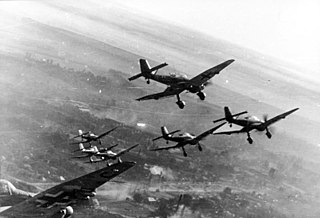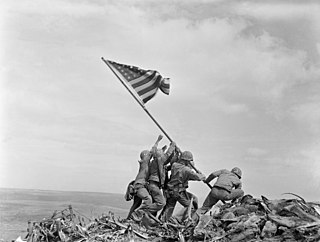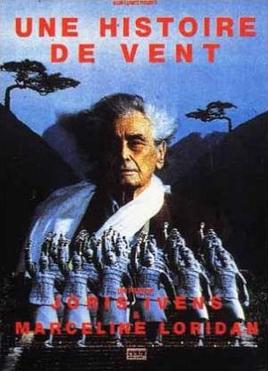Related Research Articles

Georg Henri Anton "Joris" Ivens was a Dutch documentary filmmaker. Among the notable films he directed or co-directed are A Tale of the Wind, The Spanish Earth, Rain, ...A Valparaiso, Misère au Borinage (Borinage), 17th Parallel: Vietnam in War, The Seine Meets Paris, Far from Vietnam, Pour le Mistral and How Yukong Moved the Mountains.

World War II or the Second World War, often abbreviated as WWII or WW2, was a global conflict that lasted from 1939 to 1945. The vast majority of the world's countries, including all of the great powers, fought as part of two opposing military alliances: the Allies and the Axis. Many participants threw their economic, industrial, and scientific capabilities behind this total war, blurring the distinction between civilian and military resources. Aircraft played a major role, enabling the strategic bombing of population centres and the delivery of the only two nuclear weapons ever used in war. World War II was by far the deadliest conflict in history, resulting in an estimated 70 to 85 million fatalities, mostly among civilians. Tens of millions died due to genocides, starvation, massacres, and disease. In the wake of Axis defeat, Germany, Austria and Japan were occupied, and war crimes tribunals were conducted against German and Japanese leaders.

War film is a film genre concerned with warfare, typically about naval, air, or land battles, with combat scenes central to the drama. Themes explored include combat, survival and escape, camaraderie between soldiers, sacrifice, the futility and inhumanity of battle, the effects of war on society, and the moral and human issues raised by war. The stories told may be fiction, historical drama, or biographical.

Why We Fight is a series of seven propaganda films produced by the US Department of War from 1942 to 1945, during World War II. It was originally written for American soldiers to help them understand why the United States was involved in the war, but US President Franklin Roosevelt ordered distribution for public viewing.

The 1930s was a decade that began on January 1, 1930, and ended on December 31, 1939. In the United States, the Dust Bowl led to the nickname the "Dirty Thirties".

The "March of the Volunteers", originally titled the "March of the Anti-Manchukuo Counter-Japan Volunteers", has been the official national anthem of the People's Republic of China since 1978. Unlike previous Chinese state anthems, it was written entirely in vernacular Chinese, rather than in Classical Chinese.

The Second Sino-Japanese War was a military conflict primarily between the Republic of China and the Empire of Japan from 1937 to 1945, as part of World War II. In China, the war is called the War of Resistance against Japanese Aggression. This total war between China and the Empire of Japan is often regarded as the beginning of World War II in Asia, although some scholars consider the European War and the Pacific War to be entirely separate, albeit concurrent. It was the largest Asian war in the 20th century and has been described as "the Asian Holocaust", in reference to the scale of Imperial Japan's war crimes against Chinese civilians. After the Japanese attacks on Malaya and Pearl Harbor in 1941, the war merged with other conflicts which are generally categorized under the China Burma India Theater of World War II.

The Pacific War, sometimes called the Asia–Pacific War, was the theater of World War II that was fought in eastern Asia, the Pacific Ocean, the Indian Ocean, and Oceania. It was geographically the largest theater of the war, including the vast Pacific Ocean theater, the South West Pacific theater, the Second Sino-Japanese War, and the Soviet–Japanese War.

The causes of World War II have been given considerable attention by historians. The immediate precipitating event was the invasion of Poland by Nazi Germany on September 1, 1939, and the subsequent declarations of war on Germany made by Britain and France, but many other prior events have been suggested as ultimate causes. Primary themes in historical analysis of the war's origins include the political takeover of Germany in 1933 by Adolf Hitler and the Nazi Party; Japanese militarism against China, which led to the Japanese invasion of Manchuria and the Second Sino-Japanese War; Italian aggression against Ethiopia, which led to the Second Italo-Ethiopian War, the consent of Western countries to Germany's actions on the annexation of Austria and the partition of Czechoslovakia and Germany's initial success in negotiating the Molotov–Ribbentrop Pact with the Soviet Union to divide the territorial control of Eastern Europe between them.

Frank Humphrey Sinkler Jennings was an English documentary filmmaker and one of the founders of the Mass Observation organisation. Jennings was described by film critic and director Lindsay Anderson in 1954 as "the only real poet that British cinema has yet produced".

This timeline of events preceding World War II covers the events that affected or led to World War II.

The Allies, formally referred to as the United Nations from 1942, were an international military coalition formed during World War II (1939–1945) to oppose the Axis powers, led by Nazi Germany, the Empire of Japan, and the Kingdom of Italy. Its principal members by the end of 1941 were the "Big Four" - United Kingdom, United States, Soviet Union, and China.
The following outline is provided as an overview of and topical guide to World War II:

Stilwell and the American Experience in China, 1911–45 is a work of history written by Barbara W. Tuchman and published in 1971 by Macmillan Publishers. It won the 1972 Pulitzer Prize for General Non-Fiction. The book was republished in 2001 by Grove Press It was also published under the title Sand Against the Wind: Stilwell and the American Experience in China, 1911–45 by Macmillan Publishers in 1970.
The Song of the Rivers is a 1954 documentary film production by the East Germany film studio DEFA. Dutch filmmaker Joris Ivens was the leading director. The sprawling film celebrates international workers movements along six major rivers: the Volga, Mississippi, Ganges, Nile, Amazon and the Yangtze. Shot in many countries by different film crews, and later edited by Ivens, Song of the Rivers begins with a lyrical montage of landscapes and laborers and proceeds to glorify labor and modern industrial machinery. The musical score is by Dmitri Shostakovich, with lyrics written by Bertolt Brecht, and songs performed by German communism's star Ernst Busch and famous American actor, singer and activist Paul Robeson who also narrates. Song of the Rivers is an ode to international solidarity.
Helen Victoria van Dongen was a pioneering editor of documentary films who was active from about 1925–1950. She collaborated with filmmaker Joris Ivens from 1925 to 1940, made several independent documentaries, and edited two of Robert Flaherty's films before retiring from filmmaking in her 40s.

Rain is a 1929 Dutch short documentary film directed by Mannus Franken and Joris Ivens. It premiered on 14 December 1929, in the Amsterdam Filmliga's theater, De Uitkijk.

A Tale of the Wind is a 1988 French film directed by Joris Ivens and Marceline Loridan. It is also known as A Wind Story. It stars Ivens as he travels in China and tries to capture winds on film, while he reflects on his life and career. The film blends real and fictional elements; it ranges from documentary footage to fantastical dream sequences and Peking opera. It was Ivens' last film.
The 27th annual Venice International Film Festival was held from 28 August to 10 September 1966.

Xu Xiaobing 徐肖冰 was a Chinese cinematographer, filmmaker, and photojournalist. The Chinese Communist Party commissioned Xu and his wife, Hou Bo, to make an official photographic record to share with the Chinese and world public of Party leaders, scenes of battle, and vignettes of everyday life during the Second Sino-Japanese War (1937–1945) and especially of Mao Zedong from the 1930s down to the 1960s. The couple shot many of the best-known photos of Mao and other leaders.
References
- 1 2 3 4 5 Anderson, Kevin Taylor. "The 400 Million (Holland, Ivens, 1938)" in Encyclopedia of the Documentary Film, Vol. 1, pp. 432 f. Routledge (New York), 2006.
- 1 2 3 4 5 Anderson, Kevin Taylor. "The 400 Million (Holland, Ivens, 1939)" in The Concise Routledge Encyclopedia of the Documentary Film, pp. 262 f. Routledge (New York), 2013. ISBN 9780415596428.
- ↑ Tanner, Harold Miles. China: A History, Vol. 2: "From the Great Qing Empire through the People's Republic of China", p. 146, n. 33. Hackett (Indianapolis), 2010. ISBN 9781603842020.